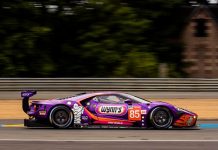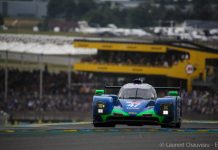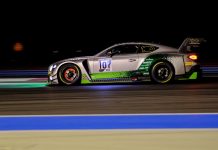The dynamic and beautiful Mazda RT24-P will make its race debut this weekend at the 55th running of the Rolex 24 at Daytona. The historic 24-hour race kicks off the 2017 IMSA WeatherTech SportsCar Championship, beginning Saturday afternoon at 2:30 PM ET (Coverage on FOX-TV begins at 2 PM ET) from the 3.56-mile road course at the Daytona International Speedway. The two-car Mazda team will race in the top class, Prototype, and features six drivers: Jonathan Bomarito, Tristan Nunez and Spencer Pigot will drive the No. 55 Mazda, while Tom Long, Joel Miller and James Hinchcliffe will pilot the ModSpace/Castrol Edge No. 70 car.
Mazda has earned 22 class victories at the Rolex 24 (second among all manufacturers), but an overall victory has eluded the brand. Since Mazda first came to Daytona in 1973, the new Mazda RT24-P cars present the best opportunity to earn an overall triumph. The cars were built under the new Daytona Prototype international (DPi) regulations, with bodywork created using Mazda’s KODO—Soul of Motion design language that clearly echoes the looks of the full line of Mazdas on the showroom floor. KODO represents the instant that energy becomes motion, such as when an animal pounces on its prey. The cars will carry two distinctly Mazda colors: the No. 55 car features Soul Red, while the No. 70 car will race in Machine Gray.
As with any brand new race car, the first race is always a litmus test of the reliability of thousands of components. That the first race is a grueling 24-hour endurance grind only heightens the reliability concerns for the entire field of brand new Prototypes. Given the non-stop work in the past several months by the Mazda Prototype crew, the cars are prepared and ready to race. As the night falls, driver endurance will also become a key element for success.
The Mazda entries have squads of three drivers, which means each will have to average eight hours in the car, in increments of two to three hours at a time. The drivers are subjected to high temperatures, extreme noise, constantly changing lateral G-forces and a heart rate averaging approximately 170 beats per minute. Without the luxury of timeouts while battling 54 other cars on-track, a driver must be exceptionally fit to handle those demands while remaining physically and mentally fresh.
Full-time Training
For each Mazda driver, training for the 24 Hours has been an on-going effort. They train year-round to achieve the proper balance between muscle, flexibility and endurance.
“You can’t just train for two weeks to be in shape for the 24,” said Joel Miller. “It has to be your lifestyle and months of training. [A driver’s] first stint of the race, even if you’re in the car for several hours, that’s easy. Anyone can train for that. You get through it on adrenaline. Then, when you get back in the car for the second stint, even that is OK. But, the third and fourth stints, usually in the wee hours of the morning, are really where fatigue can set in. You can’t make mental mistakes or get burnt out physically. That’s when you see the drivers who are in the best condition are going to have that reserve of energy that will take them to the front.”
Prolonging the Onset of Fatigue
A driver’s exercise routine can’t be a generic, one-size-fits-all effort. The Mazda drivers have altered their programs to focus on specific muscle groups that are most impacted by the new car compared to the previous chassis. From a more reclined seating position to a smaller, more restrictive cockpit area and a steering wheel that is closer to the driver, each of those distinctions forces them to train certain muscle groups differently.
“You are working to prolong the onset of fatigue,” said Tom Long. “Another aspect to deal with is the higher downforce level. Because the car is much faster, the overall load on your entire body is greater. That starts with your neck holding your head up, then from your shoulders and through your arms. Your core does a lot of the stabilization when cornering, and your hips take on a lot of the force laterally. I’ve been doing a lot of upper and lower back training and working all of the muscle groups around the hips because of what I felt while testing at Daytona.”
IndyCar racer Hinchcliffe, who is joining the Mazda team at Daytona for the fifth time, finished runner-up in the 2016 season of ABC-TV’s “Dancing with the Stars.” But, he found the weeks of constant dancing made him much leaner with a loss of muscle mass. He spent the holiday months pushing hard to regain that strength.
“The downforce levels have come up since the last time I drove a Prototype [in 2015],” said Hinchcliffe. “That’s all part of the training. We will have to do it for a long time – a lot of hours in a short period in the grand scheme of things – but I’m used to doing three-hour IndyCar races so hopefully doing a three-hour stint in this car won’t be a huge deal. Except you’ve got to rest a few hours and then do it all again!”
Mazda Teams with Jim Leo, Driver Fitness Expert
After Hinchcliffe suffered grave injuries in a crash at Indianapolis in 2015, one of the key elements of his speedy rehabilitation was working with Jim Leo, owner of PitFit Training in Indianapolis. Leo’s high performance training plays a big role for Hinchcliffe, fellow IndyCar/Mazda Prototype racer Spencer Pigot and many of the top race car drivers in the world. For the Rolex 24 at Daytona, Leo has teamed with Mazda Motorsports to work with all of the drivers on food, hydration and exercises to help them prepare and then recover quickly.
Here are a few of the many things Leo and the PitFit Training team will provide for each driver during the race:
Before climbing in the car: Drivers will be weighed and provided stretching and massage. Fast-twitch muscle fibers are prepared and alertness heightened.
After: Drivers are weighed again, fluid loss determined, and provided proper fluids to recover. Drivers are taken out of “fight or flight” mode and put into an “advanced recovery state” with audio to help calm brainwaves. They receive stretching, injury treatment and nutrition.
Rest: PitFit provides sleep tracking devices which measure sleep patterns, heart rates, respiration rate, room temperature and humidity. This determines how well-rested the driver is. (Drivers traditionally sleep in intervals of 90 minutes between segments in the race car.)
“It’s exciting for PitFit Training to partner with Mazda for the Rolex 24,” said Leo. “We’ve been working hard with James and Spencer’s training in Indianapolis to prepare for this event, and look forward to increasing that support trackside for Mazda’s DPi lineup. Our goal is to have every driver on the team at peak levels with every lap they turn. The new Mazda RT24-P is going to be a competitive car, and we will do everything to ensure the drivers are at their optimal performance as well.”
With months of preparation, Mazda’s Prototype drivers are ready for a battle to the finish, and it may come down to which driver prepared more completely in the off-season.
Now, who’s brave enough to say that race car drivers aren’t athletes?









